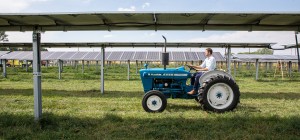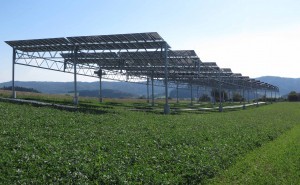
Agrivoltaics combines agriculture with photovoltaics, making the most of the land by providing both energy production as well as food and other crops. It takes vast swaths of land to generate the power needed for hundreds or thousands of homes, but through this shared use method, it’s a winning proposition all the way around.
According to the Fraunhofer Institute for Solar Energy Systems ISE, agrivoltaics has made significant progress in recent years and spreading to nearly every region in the world. The agrivoltaics capacity installed worldwide has grown from around five megawatts (MW) in 2012 to approximately 2.9 GW in 2020, with China producing the greatest share of installed capacity at around 1.9 GW.
The many benefits
Many benefits go beyond the production of necessary food and energy: Crops are protected from drought and damage caused by the increase in extreme weather events that the world is experiencing. The solar panels provide partial shade, thus reducing the rate of evaporation—much needed in dry, arid lands. And the panels can improve habitat for other useful flora and fauna including birds, bats and bees.
“Agrivoltaics provide a rare chance for true synergy: more food, more energy, lower water demand, lower carbon emissions, and more prosperous rural communities,” said Chad Higgins, an associate professor in Oregon State’s College of Agricultural Sciences and the senior author of the paper “Agrivoltaics Align with Green New Deal Goals While Supporting Investment in the US’ Rural Economy” published in the journal Sustainability.

Higgins and his group at Oregon State studied the potential of agrivoltaics, including the initial investment, job creation, and energy production. Their initial research focused on the impact solar arrays had on the crops planted around them, which showed that crop yield is dependent on the type of crop. In the end they determined that when the value of the electricity generated by the solar panels is included, there is an economic net benefit from the agrivoltaic systems. Read more about this work in “Solar Energy and Agriculture Can Mitigate Climate Change”.
Challenges
As in the adoption of any new technology, several challenges stand in the way of widespread use of agrivoltaics. First there is the investment cost, which is high compared to traditional, free-standing solar. Part of this cost includes a site-specific design, which takes the agricultural needs into account. For example, how much shade and sun does a particular crop need. However, the opportunities agrivoltaics open up for agriculture and the energy transition are great, according to the Fraunhofer Institute for Solar Energy Systems ISE analysis, published in their recent guidelines, agrivoltaics is already competitive with other renewable energy sources today. At seven-to-twelve-euro cents per kWh, agrivoltaics offers levelized electricity production costs that currently remain higher than those of traditional free-standing installations, but are already below those of small rooftop PV systems. Read more about the Fraunhofer ISE guidelines in “Dual-Yield on Arable Land: Fraunhofer ISE publishes guidelines for agrivoltaics”.
Agrivoltaic installations
While agrivoltaics is a young technology, there are examples of its use throughout the world. In the Gobi Desert in China, for example, where one would think there would no agricultural land, berries are being cultivated in what may e the world’s largest agrivoltaic installation to date. In this remote, off-grid area, the solar panels shade the crops, thus reducing the need for water. Not only are berries being grown, but the system has achieved an output of 700MW of solar power.
In the state of Maharasthra in India, Fraunhofer ISE found that an agrivoltaic installation is providing the shade needed to boost yields of tomato and cotton crops by up to 40%.
In the United States, a site known as Jack's Solar Garden, located in Boulder County, Colorado is currently the largest agrivoltaic research installation in the country. The 1.2MW community solar garden Jack's sits on five acres of farmland and is being used as a testbed to study how best to grow wildflowers, pasture and prairie grasses, pollinator habitats, as well as crops, such as carrots, onions, tomatoes and squash. In addition, the solar array produces enough power for over 300 homes. Read more about Jack’s Solar Garden in “Largest Agrivoltaic Research Project in U.S. Using Solar Trackers”.
Learning more about agrivoltaics
Agrivoltaics is still a very young technology, and the Fraunhofer ISE guidelines lay out the benefits, challenges and the work that needs to be done. One example of a challenge is the Renewable Energy Sources Act (EEG) in Germany, where most agrivoltaic systems do not receive cost-covering feed-in tariffs, and the agricultural use of the land is excluded from EU agricultural subsidies. Furthermore, the building code does not privilege land-neutral agrivoltaics. These are obstacles that are barriers to implementation of this beneficial technology. The Guideline authors propose changes to better embed agrivoltaics in the regulatory framework, in Germany, which can perhaps be used as a model elsewhere. Read more about the guidelines in “Dual Yield on Arable Land: Fraunhofer publishes guidelines for agrivoltaics”.
Agrivoltaics will be front and center at Intersolar Europe this year, as the conference is providing providing support for the international AgriVoltaics2021 conference. Two of the agrivoltaic sessions include “Agrivoltaics: Harvesting the Sun While Cultivating Crops and Vertical Farming” and “Renewables: The Nexus of Water, Energy, and Food.” The online event will be held from June 14 to 16, 2021.Read more about agrivoltaics at Intersolar in “A Focus on Agrivoltaics at Intersolar Europe 2021”.
A farming future
Looking to the future, Professor Higgins from Oregon State believes the wide-scale installation of agrivoltaic systems opens the door for other technologies such as powering electric tractors, generating fertilizer. Or taking the farm one step further into the future sensors could be installed on the solar panel platforms to support artificial intelligence-based decisions to improve agricultural productivity. “Once we have infrastructure, once we have energy, we are ready to tackle so many more big problems,” Higgins said.
Written by Anne Fischer, Editorial Director, Novus Light Technologies Today
































 Back to Features
Back to Features



























